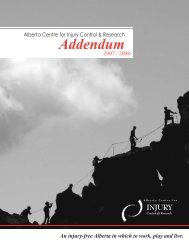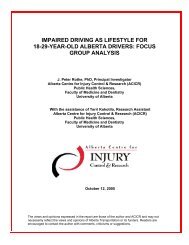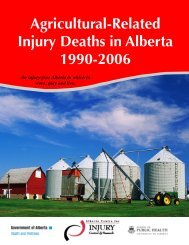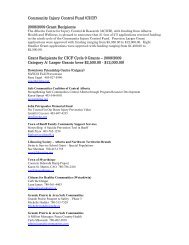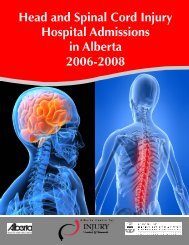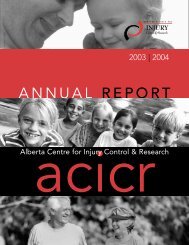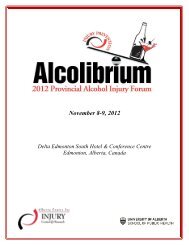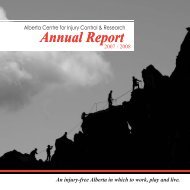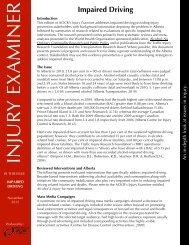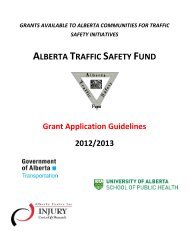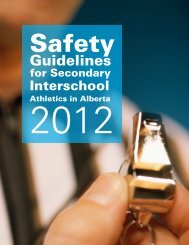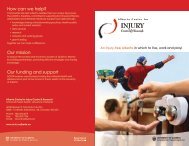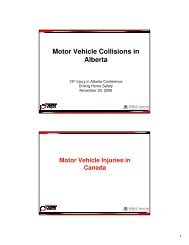JUNE 2003 - Alberta Centre for Injury Control & Research
JUNE 2003 - Alberta Centre for Injury Control & Research
JUNE 2003 - Alberta Centre for Injury Control & Research
Create successful ePaper yourself
Turn your PDF publications into a flip-book with our unique Google optimized e-Paper software.
• Four out of 10 First Nations people in <strong>Alberta</strong> died due to injury and<br />
poisoning between 1983 and 1999.<br />
• <strong>Injury</strong> is estimated to account <strong>for</strong> over half of potential years of life lost<br />
among First Nations in Canada.<br />
• Motor vehicle collisions, followed by suicide are the leading causes of injury<br />
related death among First Nations people.<br />
• The suicide rates <strong>for</strong> First Nations people in Canada are eight times that of<br />
the non-Aboriginal population.<br />
• In 2001, 86% of all hypothermia deaths with alcohol levels exceeding the<br />
legal limit to drive in <strong>Alberta</strong> were Aboriginal persons.<br />
• During the 10-year period of 1989-1998 First Nation Reserves in <strong>Alberta</strong><br />
accounted <strong>for</strong> 1% of all fires but 12.3% of all fire deaths.<br />
The cost of injuries in First Nations communities is estimated at $14 billion<br />
per year (1993). This cost includes direct and indirect costs. The impact of<br />
the injuries ranges from premature death, loss of family members, loss of<br />
family income and loss of productivity and member contribution.<br />
The First Nations and Inuit Health Branch of Health Canada, <strong>Alberta</strong> Region,<br />
undertook a consultation process with First Nations communities to better<br />
understand the nature of the injury problems and challenges in First Nations<br />
communities. The consultation process resulted in key principles, themes and<br />
recommendations <strong>for</strong> addressing the challenges. These are described in the<br />
report First Nations Communities in <strong>Alberta</strong>. A Dialogue <strong>for</strong> Action<br />
Planning: Addressing the Problem of Injuries. 24<br />
Farming injuries<br />
<strong>Alberta</strong> has a large agricultural population and economy. Like other areas,<br />
those involved in farming have also incurred injuries. Data was analyzed by<br />
the ACICR, using the Canadian Agricultural <strong>Injury</strong> Surveillance Program. 25<br />
Some facts about injuries associated with farming follow.<br />
• In <strong>Alberta</strong> between 1990 and 2000, 163 fatalities were associated with<br />
working on a farm.<br />
• The <strong>Alberta</strong> rate/100,000 farm population <strong>for</strong> fatalities associated with<br />
working on a farm was 7.9, the lowest in Canada.<br />
• Tractor-related fatalities accounted <strong>for</strong> 38% of all farm fatalities.<br />
• The highest at-risk group <strong>for</strong> fatalities associated with working on a farm are<br />
children and seniors.<br />
• The leading cause of a fatal farm injury is being pinned or struck by the<br />
machinery. However, among children aged less than 15 the leading cause is<br />
being run over by machinery.<br />
Making <strong>Alberta</strong> the Safest Place to Live<br />
78



